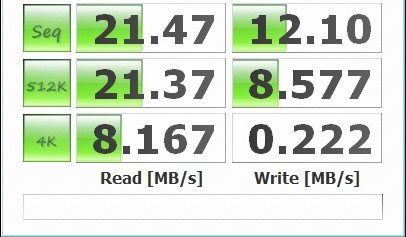Crystal Disk Mark
While it’s easy to test just the sequential read and write rates, it won’t explain why some flash drives seemingly transfer data more nimbly. That’s why I’ve included the 512K and 4K data block tests as well.

SuperTalent 8GB SSP 2.0
We begin by checking the performance of my SuperTalent 8GB flash drive. Sequential performance is roughly 21.4 MBs read and 12.1 MB/s write. The 4KB read rate is actually pretty surprising at 8.1 MB/s read, but not so much with the .22 MB/s write which equates in to longer wait times when moving data to the flash drive.

DataTraveler 8GB HyperX 2.0
Next, I plugged in my HyperX DataTraveler 2.0 which is a little newer. Sequential read was 31.1 MB/s and write 23.4 MB/s which is noticeably higher. However, 4KB read speeds were only .015 MB/s which is why adding data takes so long as well.

DataTraveler 32GB Ultimate 3.0
Finally, the DataTraveler Ultimate 3.0 was connected to the motherboard’s blue USB port. Sequential read jumps to a whopping 87.2 MB/s and 64 MB/s write. Small 4KB block performance answers the question why USB 3.0 is so fast. Read speeds were 5.1 MBs which was lower than the other two, but write speeds were 11.6 MB/s.
Even compared to the results a couple of other 32GB flash dries reviewed over the last few months, the DTU 3.0 is clearly ahead. Patriot’s Xporter Rage 32GB Extreme scored 25.55MB/s read and 18.43MB/s write. The DTU 3.0’s cousin, the Kingston DataTraveler 150 32GB scored a lower 29.34 MB/s read and 12.68MB/s write speeds, further solidifying it’s place as a top performer.
Because the DTU 3.0 4KB write speed is so much faster, it’s what really gives the flash drive its wings which is extremely handy for desktop and office users that really want some grab and go storage that keeps up with them. In order to better help you understand how that applies to you, let’s move on to my time trial file transfer.
Time Trial File Transfer
The concept is simple. I simply moved a 1.92GB folder filled with pictures, text, and videos to and from the flash drives. There’s so many different sized data blocks in this file that it will put any controller to work, especially these flash drives.

As you can see, the DTU 3.0 essentially leaves the others in the dust thanks to the power of a USB 3.0 controller. I tested the DTU in USB 2.0 mode using the wire adapter as well. Oddly, it’s a bit slower writing to the flash drive. This could be because the flash memory is tuned for the 3.0 controller rather than the 2.0 controller. But, transferring the file back to the PC, it makes a little gain over the USB 2.0 HyperX DataTraveler.
While I didn’t include my free “Black Friday” 4GB flash drive, it probably wouldn’t shock you to know it took 8:53 to write the file and 5:21 to put it back on my PC. That thing use to take so long that I could take my time refilling my coffee cup between transfers.
Final Thoughts
Simply put, USB 3.0 is now fast enough to make you think you have a lower end SSD within your system. While it’s not meant to be your primary storage, it is meant to be a more improved, quick, portable storage solution. While you could pick up an external USB 3.0 enclosure and a SATA2 hard drive and experience even higher performance, it’s not nearly as portable, durable or as convenient as the Kingston DataTraveler Ultimate 3.o flash drive.
Currently, the DTU 3.0 prices in at a premium at $99.99 US for the 32GB model. While it seems like that might be a bit high, that’s roughly about $3.12 a GB. It’s also not that far off from the pricing of other slower USB 2.0 drives of the same capacity. When you put it in that perspective, it’s not actually such a bad value. Plus, as more USB 3.0 motherboards and PCI controller cards make their way into our homes and offices, prices will continue to fall.
In the meantime, the DataTraveler Ultimate 3.0 provides real world performance that I can really feel in day to day tasks. As a result, it’s become my new favourite.
Pros:
- Comes in high capacities from 16GB to 64GB
- Great transfer rates compared to USB 2.0
- High performance allows more uses than just storage
- A good looking drive!
Cons:
- Early adopter premium pricing
Overall Rating: 9.0 / 10.0
Love This Review? Hate This Review? Leave a Comment or Hit The Forums!

